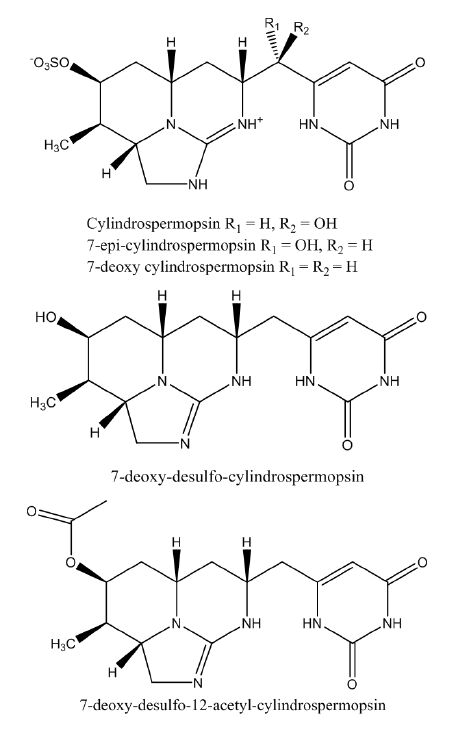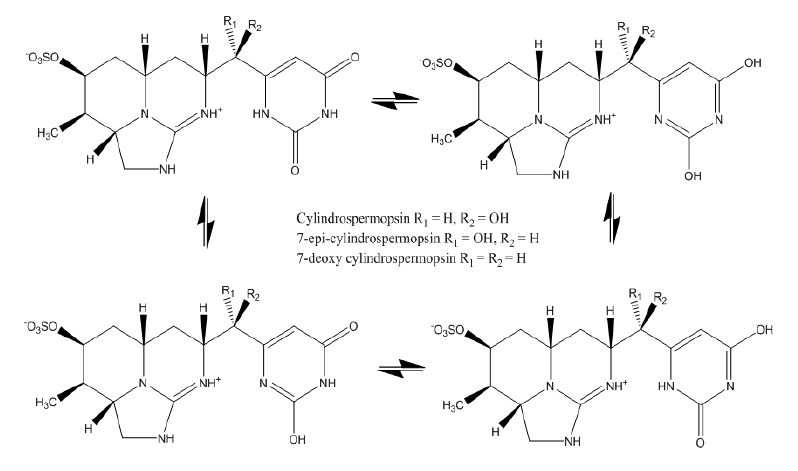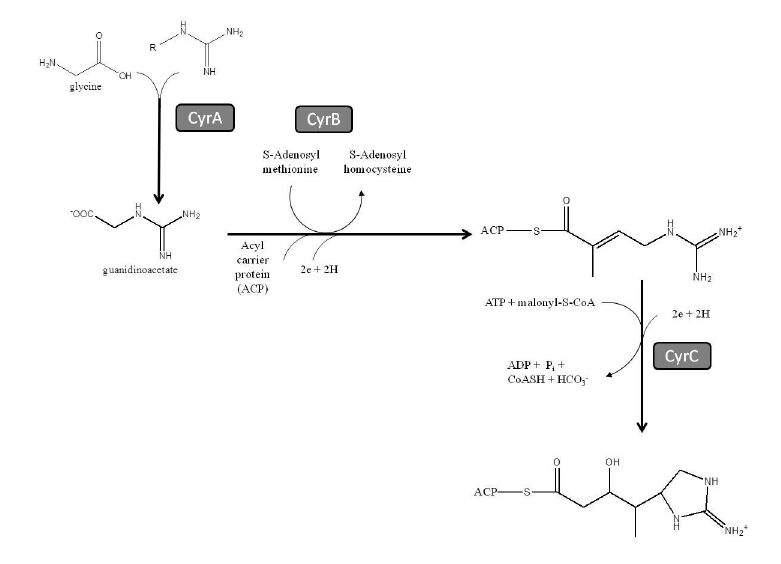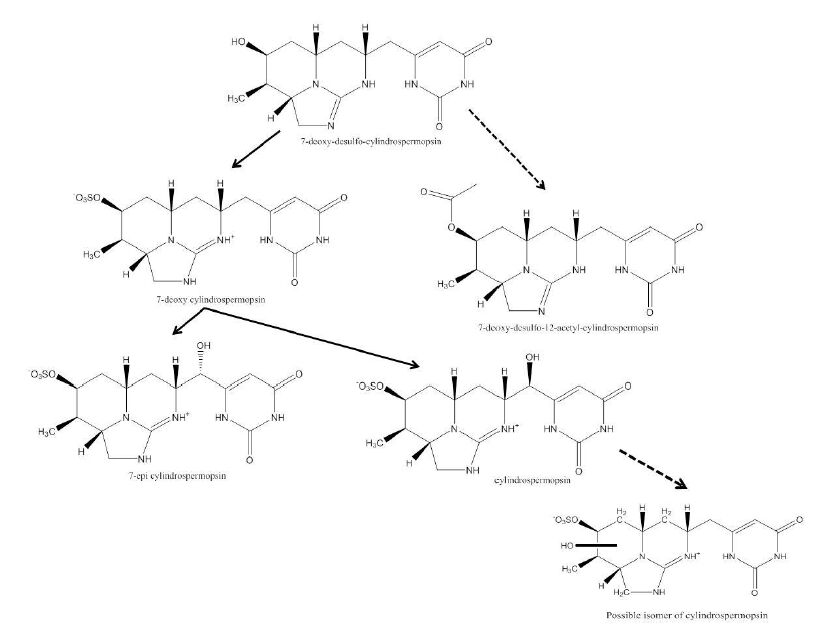The existence of a number of cylindrospermopsin analogs has been confirmed by several authors. These cylindrospermopsin analogs were formerly seen as minor constituents, with normal cylindrospermopsin always being the dominant form. However, it is now clear that the cylindrospermopsin analogs are the major species produced by certain organisms, the production being enhanced, at least in some cases, under specific physiological conditions. Presently, relatively little information is available concerning the properties, physiology of occurrence and toxicity of these molecules. The existing literature pertaining to these aspects is reviewed with respect to known cylindrospermopsin analogs.
The biosynthesis of the cylindrospermopsins is discussed and the previously established pathway has been modified to take account of the production of the known cylindrospermopsin forms. The anomalies in terms of in-vivo toxicity of 7-deoxy-cylindrospermopsin are reported, along with further attempts to rationalize the situation. We also discuss reasons for the apparently similar toxicity of 7-deoxy-cylindrospermopsin and cylindrospermopsin to cell cultures in vitro. It is hypothesized that the similarity of cylindrospermopsin intoxication to nonalcoholic fatty liver disease may argue for these cyanotoxins to exert their effects via a lysosomal pathway.
1.
A simple review of recent developments
Recall from [1, p. 804, Entry 23.1.1] that the Bernoulli numbers $ B_n $ can be generated by
Since the function $ \frac{x}{{\rm{e}}^x-1}-1+\frac{x}2 $ is even in $ x\in\mathbb{R} $, all the Bernoulli numbers $ B_{2n+1} $ for $ n\ge1 $ are equal to $ 0 $. The first six non-zero Bernoulli numbers $ B_n $ are
Recall from [2, Chapter 1] that the Bernoulli polynomials $ B_n(x) $ can be generated by
It is clear that $ B_n(0) = B_n $. The first four Bernoulli polynomials $ B_n(x) $ are
The Bernoulli numbers $ B_n $ and the Bernoulli polynomials $ B_n(x) $ are classical and fundamental notions in both mathematical sciences and engineering sciences.
We now give a simple review of recent developments of the Bernoulli numbers $ B_n $ and the Bernoulli polynomials $ B_n(x) $, including inequalities, monotonicity, determinantal expressions, signs of determinants, and identities related to the Bernoulli numbers $ B_n $ and the Bernoulli polynomials $ B_n(x) $.
In [3], Alzer bounded the Bernoulli numbers $ B_n $ by the double inequality
for $ n\ge1 $, where $ \alpha = 0 $ and $ \beta = 2+\frac{\ln(1-6/\pi^2)}{\ln2} = 0.6491\dotsc $ are the best possible in the sense that they can not be replaced by any bigger and smaller constants respectively in the double inequality (1.3).
In [4,5], Qi bounded the ratio $ \frac{B_{2n+2}}{B_{2n}} $ by
The double inequality (1.4) was generalized and refined in [6,7]. This double inequality has had a number of non-self citations in over forty-eight articles or preprints published by other mathematicians.
In [8], Y. Shuang et al. proved that the sequence $ \bigl|\frac{B_{2n+2}}{B_{2n}}\bigr| $ for $ n\ge0 $ and the sequences
for fixed $ \ell\ge1 $ are increasing in $ n $.
In the papers [9,10], many determinantal expressions of the Bernoulli numbers $ B_n $ and the Bernoulli polynomials $ B_n(x) $ are reviewed and discovered. For example, the Bernoulli polynomials $ B_n(x) $ for $ n\ge0 $ can be expressed in terms of the determinant of a Hessenberg matrix as
and, consequently, the Bernoulli numbers $ B_n $ for $ n\ge0 $ can be expressed as
In [11], basing on the increasing property of the sequences in (1.5), among other things, Qi determined signs of certain Toeplitz–Hessenberg determinants whose elements involve the Bernoulli numbers $ B_{2n} $. For example, for $ n\ge1 $ and $ \alpha > \frac{5}{6} $,
and
The rising factorial $ (\alpha)_k $ is defined [12] by
The central factorial numbers of the second kind $ T(n, k) $ for $ n\ge k\ge0 $ can be generated [13,14] by
In [15], considering the power series expansion
for $ \alpha < 0 $, which was established in [16, Theorem 4.1], X.-Y. Chen et al. derived the closed-form expression
and two identities
and
There have been a simple review about closed-form formulas for the Bernoulli numbers and polynomials at the web sites https://math.stackexchange.com/a/4256911 (accessed on 5 February 2023), https://math.stackexchange.com/a/4256914 (accessed on 5 February 2023), and https://math.stackexchange.com/a/4656534 (accessed on 11 March 2023). For more recent developments of the Bernoulli numbers $ B_n $ and the Bernoulli polynomials $ B_n(x) $, please refer to the monograph [17], to the papers [18,19,20,21,22,23,24], and to the articles [25,26,27,28,29,30,31,32,33].
2.
A motivation of this paper
Let
denote the differences between the Bernoulli polynomials $ B_n(x) $ and the Bernoulli numbers $ B_n $. Subtracting (1.1) from (1.2) on both sides yields
It is easy to see that
and $ Q_n(0) = 0 $ for $ n\ge0 $. Accordingly, Eq (2.1) can be reformulated as
The values of $ Q_n(x) $ for $ 1\le n\le4 $ are
For $ \alpha, \beta\in\mathbb{R} $ such that $ \alpha\ne\beta $, $ (\alpha, \beta)\ne(0, 1) $, and $ (\alpha, \beta)\ne(1, 0) $, let
In the papers [34,35,36], the monotonicity and logarithmic convexity of $ \mathcal{Q}_{\alpha, \beta}(t) $ were discussed and the following conclusions were acquired:
1. the function $ \mathcal{Q}_{\alpha, \beta}(t) $ is increasing on $ (0, \infty) $ if and only if $ (\beta-\alpha)(1-\alpha-\beta)\ge0 $ and $ (\beta-\alpha) (|\alpha-\beta| -\alpha-\beta)\ge0 $,
2. the function $ \mathcal{Q}_{\alpha, \beta}(t) $ is decreasing on $ (0, \infty) $ if and only if $ (\beta-\alpha)(1-\alpha-\beta)\le0 $ and $ (\beta-\alpha) (|\alpha-\beta| -\alpha-\beta)\le0 $,
3. the function $ \mathcal{Q}_{\alpha, \beta}(t) $ is increasing on $ (-\infty, 0) $ if and only if $ (\beta-\alpha)(1-\alpha-\beta)\ge0 $ and $ (\beta-\alpha) (2-|\alpha-\beta| -\alpha-\beta)\ge0 $,
4. the function $ \mathcal{Q}_{\alpha, \beta}(t) $ is decreasing on $ (-\infty, 0) $ if and only if $ (\beta-\alpha)(1-\alpha-\beta)\le0 $ and $ (\beta-\alpha) (2-|\alpha-\beta| -\alpha-\beta)\le0 $,
5. the function $ \mathcal{Q}_{\alpha, \beta}(t) $ is increasing on $ (-\infty, \infty) $ if and only if $ (\beta-\alpha) (|\alpha-\beta| -\alpha-\beta)\ge0 $ and $ (\beta-\alpha) (2-|\alpha-\beta| -\alpha-\beta)\ge0 $,
6. the function $ \mathcal{Q}_{\alpha, \beta}(t) $ is decreasing on $ (-\infty, \infty) $ if and only if $ (\beta-\alpha) (|\alpha-\beta| -\alpha-\beta)\le0 $ and $ (\beta-\alpha) (2-|\alpha-\beta| -\alpha-\beta)\le0 $,
7. the function $ \mathcal{Q}_{\alpha, \beta}(t) $ on $ (-\infty, \infty) $ is logarithmically convex if $ \beta-\alpha > 1 $ and logarithmically concave if $ 0 < \beta-\alpha < 1 $,
8. if $ 1 > \beta-\alpha > 0 $, then $ \mathcal{Q}_{\alpha, \beta}(t) $ is $ 3 $-log-convex on $ (0, \infty) $ and $ 3 $-log-concave on $ (-\infty, 0) $,
9. if $ \beta-\alpha > 1 $, then $ \mathcal{Q}_{\alpha, \beta}(t) $ is $ 3 $-log-concave on $ (0, \infty) $ and $ 3 $-log-convex on $ (-\infty, 0) $.
The monotonicity of $ \mathcal{Q}_{\alpha, \beta}(t) $ on $ (0, \infty) $ was used in [34,37,38] to present necessary and sufficient conditions for some functions involving ratios of the gamma and $ q $-gamma functions to be logarithmically completely monotonic. The logarithmic convexity of $ \mathcal{Q}_{\alpha, \beta}(t) $ on $ (0, \infty) $ was employed in [36,39] to provide alternative proofs for Elezović-Giordano-Pečarić's theorem. For more detailed information, please refer to [40,41] and related references therein. The above texts are extracted and modified from [42, pp. 486–487].
The generating function $ \frac{{\rm{e}}^{xz}-1}{{\rm{e}}^z-1} $ in (2.3) can be reformulated as
Consequently, we deduce properties of the generating function $ \mathcal{Q}_{1-x, 1}(t) = \frac{{\rm{e}}^{xt}-1}{{\rm{e}}^t-1} $ in (2.3) as follows:
1. the function $ \mathcal{Q}_{1-x, 1}(t) $ is increasing on $ (0, \infty) $ if and only if $ x(x-1)\ge0 $ and $ x (|x|+x-2)\ge0 $,
2. the function $ \mathcal{Q}_{1-x, 1}(t) $ is decreasing on $ (0, \infty) $ if and only if $ x(x-1)\le0 $ and $ x (|x|+x-2)\le0 $,
3. the function $ \mathcal{Q}_{1-x, 1}(t) $ is increasing on $ (-\infty, 0) $ if and only if $ x(x-1)\ge0 $ and $ x (x-|x|)\ge0 $,
4. the function $ \mathcal{Q}_{1-x, 1}(t) $ is decreasing on $ (-\infty, 0) $ if and only if $ x(x-1)\le0 $ and $ x (x-|x|)\le0 $,
5. the function $ \mathcal{Q}_{1-x, 1}(t) $ is increasing on $ (-\infty, \infty) $ if and only if $ x (|x|+x-2)\ge0 $ and $ x (x-|x|)\ge0 $,
6. the function $ \mathcal{Q}_{1-x, 1}(t) $ is decreasing on $ (-\infty, \infty) $ if and only if $ x (|x|+x-2)\le0 $ and $ x (x-|x|)\le0 $,
7. the function $ \mathcal{Q}_{1-x, 1}(t) $ on $ (-\infty, \infty) $ is logarithmically convex if $ x > 1 $ and logarithmically concave if $ 0 < x < 1 $,
8. if $ 0 < x < 1 $, then the function $ \mathcal{Q}_{1-x, 1}(t) $ is $ 3 $-log-convex on $ (0, \infty) $ and $ 3 $-log-concave on $ (-\infty, 0) $,
9. if $ x > 1 $, then $ \mathcal{Q}_{1-x, 1}(t) $ is $ 3 $-log-concave on $ (0, \infty) $ and $ 3 $-log-convex on $ (-\infty, 0) $.
What properties do the polynomials $ Q_n(x) = B_n(x)-B_n $ for $ n\ge0 $, the differences between the Bernoulli polynomials $ B_n(x) $ and the Bernoulli numbers $ B_n $, possess?
3.
An identity involving differences between the Bernoulli polynomials and numbers
In this section, we establish an identity involving the polynomials $ Q_n(x) = B_n(x)-B_n $ for $ n\ge0 $, the differences between the Bernoulli polynomials $ B_n(x) $ and the Bernoulli numbers $ B_n $.
Theorem 3.1. For $ n\ge1 $, we have
Proof. The identity (3.1) can be reformulated as
and
where we used the identity (2.2). The last equation means that the identity (3.1) is equivalent to
where
On both sides of the identity
which is listed in [1, p. 804, Entry 23.1.7], taking $ x = 0 $ yields
This implies that
Let
for $ 1\le k\le n-1 $ and $ n\ge3 $. Therefore, we obtain
with $ A_n(0) = 0 $. This means that $ A_n(x) $ is a polynomial in $ x $ of degree $ n-1 $. Hence, in order to verify the equality (3.2), it is sufficient to show
It is immediate that
and
Differentiating $ q\ge2 $ times the polynomial $ A_n(x) $, taking the limit $ x\to0 $, and interchanging the order of repeated sums give
where we used the derivatives in (3.3) and (3.4) and utilized the identity
which is collected in [43, p. 591, Entry 24.5.3] and [44, p. 206, (15.14)].
Moreover, by the identity (3.5) again, it is easy to see that
The proof of the identity (3.1) is thus complete.
□
4.
Two identities among differences between the Bernoulli polynomials and numbers
In this section, we demonstrate two identities among $ Q_n(x) $ and $ Q_n\bigl(\frac{1}{x}\bigr) $.
The partial Bell polynomials $ B_{n, k} $ for $ n\ge k\ge0 $ are defined in [45, Definition 11.2] and [46, p. 134, Theorem A] by
This kind of polynomials $ B_{n, k} $ are important in analytic combinatorics, analytic number theory, analysis, and other areas in mathematical sciences. In recent years, some novel conclusions and applications of partial Bell polynomials $ B_{n, k} $ have been discovered, carried out, reviewed, and surveyed in the papers [12,16,47,48,49,50,51,52,53,54], for example.
Theorem 4.1. For $ n\ge1 $, we have
where the determinant of order $ 0 $ is regarded as $ 1 $ by convention.
For $ n\ge0 $, we have
Proof. The Wronski formula reads that, if $ a_0\ne0 $ and
is a formal series, then the coefficients of the reciprocal series
are given by
This can be found in [55, p. 17, Theorem 1.3], [11, Lemma 2.1 and Section 5], and [9, Lemma 2.4]. It is easy to see that the equalities (4.3) and (4.4) are equivalent to the identities $ a_0b_0 = 1 $ and $ \sum_{k = 0}^{n}a_k b_{n-k} = 0 $ for $ n\ge1 $. See [47,56,57,58].
Let $ \beta $ be a fixed real number and let
for $ n\ge0 $. It is easy to verify that $ a_0b_0 = 1 $. The identity (3.1) in Theorem 3.1 is equivalent to the equality $ \sum_{k = 0}^{n}a_k b_{n-k} = 0 $ for $ n\ge1 $. Therefore, the sequences $ a_n $ and $ b_n $ defined in (4.6) satisfy the relation (4.5). Interchanging the roles of $ a_n $ and $ b_n $ and simplifying yield (4.1).
On the other hand, if the sequences $ a_n $ and $ b_n $ satisfy $ a_0 = b_0 = 1 $ and meet the equalities (4.3) and (4.4), then
See the papers [47,48,54,59]. When $ \beta = 1 $ in (4.6), it follows that $ a_0 = b_0 = 1 $ and $ \sum_{k = 0}^{n}a_k b_{n-k} = 0 $ for $ n\ge1 $. Interchanging the roles of $ a_n $ and $ b_n $ in (4.7) and applying the sequences $ a_n $ and $ b_n $ in (4.6) result in (4.2). The proof of Theorem 4.1 is complete. □
5.
A determinantal formula of differences between Bernoulli polynomials and numbers
In this section, we derive a determinantal formula of the difference $ Q_n(x) $ as follows.
Theorem 5.1. For $ n\ge1 $, the difference $ Q_n(x) $ can be computed by
Proof. The power series expansion (2.3) implies that
The generating function $ \mathcal{Q}_{1-x, 1}(z) $ can be rewritten as
with
and
for $ k\ge0 $.
Let $ u(z) $ and $ v(z)\ne0 $ be two differentiable functions, let $ U_{(n+1)\times 1}(z) $ be an $ (n+1)\times1 $ matrix whose elements are $ u_{k, 1}(z) = u^{(k-1)}(z) $ for $ 1\le k\le n+1 $, let $ V_{(n+1)\times n}(z) $ be an $ (n+1)\times n $ matrix whose elements are
for $ 1\le i\le n+1 $ and $ 1\le j\le n $, and let $ \bigl\vert W_{(n+1)\times (n+1)}(z)\bigr\vert $ denote the determinant of the $ (n+1)\times(n+1) $ matrix
Then the $ n $th derivative of the ratio $ \frac{u(z)}{v(z)} $ can be computed [60, p. 40, Exercise 5] by
See also [61, Lemma 1], [11, Section 2], [9, p. 94, The first proof of Theorem 1.2], and [10, Lemma 1].
Applying the formula (5.2) to the functions
yields
The determinantal formula (5.1) is thus proved. □
Remark 5.1. The formula (4.5) can also be proved by the formula (5.2). For details, please refer to [11, Section 5].
Remark 5.2. For $ n\ge1 $, the determinantal formula (5.1) can be reformulated as
Since
taking the limit $ x\to0 $ on both sides of the above determinantal formula gives
for $ n\ge1 $. Consequently, we recover the determinantal formula (1.7).
Remark 5.3. The determinantal formula (5.1) can be rearranged as
Differentiating with respect to $ x $ on both sides of (5.3) and making use of the relation $ B_n'(x) = n B_{n-1}(x) $, we recover the determinantal formula (1.6).
Remark 5.4. In theory, the determinantal formula (5.1) in Theorem 5.1 can be obtained by algebraically subtracting the determinant (1.7) from the determinant (1.6).
6.
Conclusions
In this paper, about the Bernoulli numbers $ B_n $ and the Bernoulli polynomials $ B_n(x) $, we simply reviewed the inequalities (1.3) and (1.4), the increasing property of the sequence in (1.5), the determinantal formulas (1.6) and (1.7), the negativity of two determinants in (1.8) and (1.9), the closed-form formula (1.10), and the identities (1.11) and (1.12), established the identity (3.1) in Theorem 3.1 in which the differences $ Q_n(x) $ between the Bernoulli polynomials $ B_n(x) $ and the Bernoulli numbers $ B_n $ are involved, presented two identities (4.1) and (4.2) among the differences $ Q_n(x) $ in terms of a beautiful Hessenberg determinant and the partial Bell polynomials $ B_{n, k} $ in Theorem 4.1, and derived a determinantal formula (5.1) for the difference $ Q_n(x) $ in Theorem 5.1.
To the best of our authors' knowledge, the difference $ Q_n(x) $ has been investigated in this paper for the first time in the mathematical community.
Use of AI tools declaration
The authors declare they have not used Artificial Intelligence (AI) tools in the creation of this article.
Acknowledgments
The authors are grateful to three anonymous referees for their careful reading, valuable comments, and helpful suggestions to the original version of this paper.
Conflict of interest
The authors declare there is no conflicts of interest.

















 DownLoad:
DownLoad: